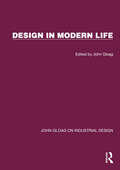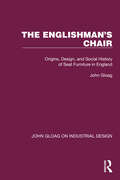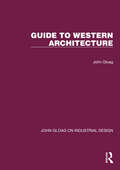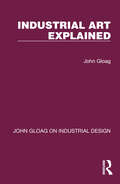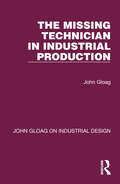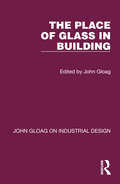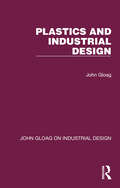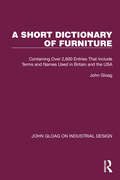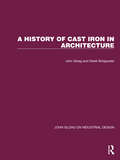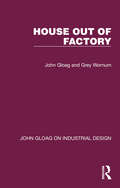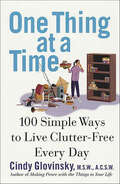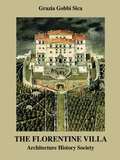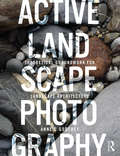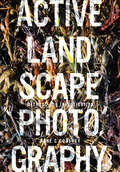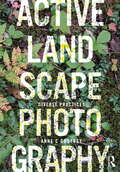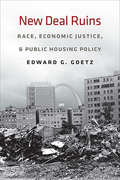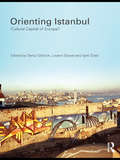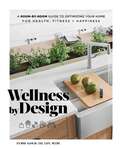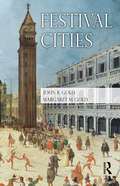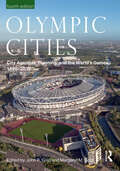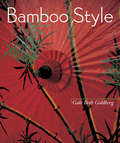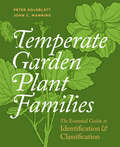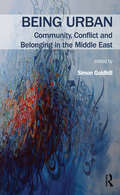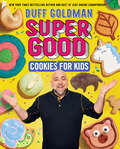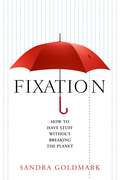- Table View
- List View
Design in Modern Life (John Gloag On Industrial Design Ser.)
by John GloagOriginally published in 1946, this book is based on a series of broadcast talks on design. Led by an engineer, an artist and critic of architecture and industrial design, the discussions focussed on the problems that were involved by a general application of design to the environment of contemporary life. It surveys the possibilities of design in modern life and the talks have been rewritten, amplified and revised for the purposes of the book.
The Englishman's Chair: Origins, Design, and Social History of Seat Furniture in England
by John GloagOriginally published in 1964, The Englishman’s Chair is a history of English chairs, written as a continuous story from the 15th to the 20th Century and because of the revealing powers inherent in chair-making and design, it is also an unconventional footnote to English social history. The changes in taste, and fashion, the increase of skill, the introduction of new materials and the long battle between dignity and comfort are discussed, as is the impact that modern industrial designers have had on chair design.
Guide to Western Architecture
by John GloagOriginally published in 1958, A Guide to Western Architecture charts the origins of the system of architectural design that was perfected in Greece, follows its development under the Roman Empire and describes the achievements of the Byzantine architects. Passing through Romanesque to Gothic, the contributions made by Mediaeval builders to structure and design are recorded, and then the impact of the Renaissance on architecture, and its characteristic development in the different European countries. The transplanting of Renaissance ideas to the New World is covered, and finally the origins and nature of the new Western architecture occupy the last section of the book. The Appendix includes a list of the principal architects, and brief notes on their work, from the 5th century B. C. to the end of the Renaissance.
Industrial Art Explained (John Gloag On Industrial Design Ser.)
by John GloagOriginally published in 1934 this book became recognised as one of the principal standard works on industrial design and industrial architecture. The chapters explain the complete operation, character and background history of industrial art, its relation to architecture, materials, industrial production and retail distribution. It is fully illustrated with line drawings and photographs.
The Missing Technician in Industrial Production (John Gloag On Industrial Design Ser.)
by John GloagOriginally published in 1944, The Missing Technician shows how Industrial Design must begin at the very first stages of planning a product. The procedure of a design research committee is outlined – a type of practical co-ordination of the work of industrial designers and production technicians which proved highly effective. The value of materials like aluminium and plastic are emphasized, but equally the importance of glass and cast iron is stressed, especially when handled in new ways that 20th Century techniques made possible.
The Place of Glass in Building (John Gloag On Industrial Design Ser.)
by John GloagOriginally published in 1943, The Place of Glass in Building is a comprehensive and compact survey of the structural uses of glass in 20th Century architecture. It gives the facts about the physical properties, the possibilities and the limitations of the glass in common use. It also deals with the attributes of specialised and decorative glass and provides detailed descriptions of the principal types which were manufactured in the UK. Intended for architectural students it may also be of interest to architects, for it is a condensed survey of the progress that has been made in this structural and decorative material.
Plastics and Industrial Design (John Gloag On Industrial Design Ser.)
by John GloagOriginally published in 1945, Plastics and Industrial Design is a non-technical work of reference for manufacturers and designers who, after the Second World War were beginning to realize the possibilities that manufacturing with Plastics could bring. The different types of plastics and their uses is discussed, as is their impact on the design of manufactured articles. Whilst the extensive use of plastic may have fallen out of favour in recent years due to environmental concerns, this book reminds us that in their infancy they offered exciting manufacturing possibilities.
A Short Dictionary of Furniture: Containing Over 2,600 Entries That Include Terms and Names Used in Britain and the USA
by John GloagOriginally published in 1952 but enlarged and revised in 1969, this dictionary became a standard authoritative work of reference. It contains 2,612 entries and over 1,000 illustrations, reproduced from contemporary sources and from drawings by Ronald Escott, Marcelle Barton and Maureen Stafford. The work is divided into 6 sections: the first and second concern the description and design of furniture, the third contains the entries, the fourth gives a list of furniture makers in Britain and North America, section five records books and periodicals on furniture and design and the concluding section sets out in tabular form the periods with the materials used, and types of craftsmen employed from 1100 to 1950.
A History of Cast Iron in Architecture (John Gloag On Industrial Design Ser.)
by John Gloag Derek BridgwaterOriginally published in 1948, A History of Cast Iron in Architecture is a comprehensive history of the part that has been played by cast iron in architecture and the allied arts in Britain. Any history of the rise and development of the iron-founding industry becomes virtually a history of the First Industrial Revolution. Examining the use of cast iron by builders and architects from late medieval times to the middle of the 20th Century the authors have also recorded a miniature history of British Industry. The introduction throws light on the early developments of iron-founding. The main sections of the book describe the rise and expansion of the cast-iron industry and its gradually increasing significance in architecture from 1650 to 1945. There are over 500 illustrations.
House Out of Factory (John Gloag On Industrial Design Ser.)
by John Gloag Grey WornumOriginally published in 1946, when Britain was facing a post-war housing crisis, this book dealt with the issue of the factory-produced house in being part of the solution for housing people in an affordable manner and a short time-scale. The book, aimed at both lay-people and technicians discusses aspects of pre-fabricated housing such as comfort, standardisation and aesthetics. The book is illustrated with 48pp of black and white plates.
One Thing at a Time: 100 Simple Ways to Live Clutter-Free Every Day
by Cindy GlovinskySimple, effective ways to put things in their placeThose piles of papers, clothes, and other things you thought you'd successfully de-cluttered have returned, and this time they brought friends. What's the use of trying to fight the clutter? Is there a better way?This powerful and useful guide delivers solutions that work, no matter how overwhelmed you feel. The answer isn't an elaborate new system, or a solemn vow to start tomorrow. Instead, psychotherapist and organizer Cindy Glovinsky shares 100 simple strategies for tackling the problem the way it grows--one thing at a time. Here's a sampling of the tips explained in the book: *Declare a fix-it day*Purge deep storage areas first *Label it so you can read it*Get a great letter opener*Practice toy population planning *Leave it neater than you found itWritten in short takes and with a supportive tone, this is an essential, refreshing book that helps turn a hopeless struggle into a manageable part of life, one thing at a time.
The Florentine Villa: Architecture History Society (The Classical Tradition in Architecture)
by Grazia Gobbi SicaScholarly and innovative with visually stunning line drawings and photographs, this volume provides readers with a compelling record of the unbroken pattern of reciprocal use and exchange between the countryside and the walled city of Florence, from the thirteenth century up to the present day. Defying the traditional and idealized interpretation of the Florentine Villa, the author: analyzes the economic factors that powered the investment in and building of country houses and estates from the early Renaissance times onwards, as well as the ideology and the architectural and literary models that promoted the Florentine villa explores the area between Florence and Sesto in its history, morphology and representation looks at the villas existing in the area. A contribution to the protection of the important cultural heritage of the landscape in the Florentine area and of its historic buildings, villas and gardens, this study makes engaging reading, not only for scholars and students in architecture, landscape design and social history, but also for the well informed reader interested in art, architecture and gardens.
Active Landscape Photography: Theoretical Groundwork for Landscape Architecture
by Anne C GodfreyPhotographs play a hugely influential but largely unexamined role in the practice of landscape architecture and design. Through a diverse set of essays and case studies, this seminal text unpacks the complex relationship between landscape architecture and photography. It explores the influence of photographic seeing on the design process by presenting theoretical concepts from photography and cultural theory through the lens of landscape architecture practice to create a rigorous, open discussion. Beautifully illustrated in full color throughout, with over 200 images, subjects covered include the diversity of everyday photographic practices for design decision making, the perception of landscape architecture through photography, transcending the objective and subjective with photography, and deploying multiplicity in photographic representation as a means to better represent the complexity of the discipline. Rather than solving problems and providing tidy solutions to the ubiquitous relationship between photography and landscape architecture, this book aims to invigorate a wider dialogue about photography's influence on how landscapes are understood, valued and designed. Active photographic practices are presented throughout for professionals, academics, students and researchers.
Active Landscape Photography: Methods for Investigation (Active Landscape Photography)
by Anne C GodfreyHow can photography be transformed into an active process of investigation for landscape architecture and environmental design? The second book in Godfrey’s series, Active Landscape Photography, presents engaged photographic methods that turn photography into a rigorous, thoughtful endeavor for the research, planning and design of landscape places. Photography is the most ubiquitous and important form of representation in these disciplines. Yet photography is not specifically taught as a core skill within these fields. This book creates a starting point for filling this gap. Concepts and working methods from contemporary photography and critical cultural theories are contextualized into situations encountered in the daily practice of landscape architecture and environmental design. These methods can be integrated into practices in academic and professional settings or picked up and self-taught by an individual reader. Part I: Methods presents easily accessible approaches to photography creating a core set of active skills. Part II: Practices discusses working methods of specific contemporary photographers and extrapolates their practices into common extrapolates their practices into common planning and design situations. Contemporary photographers presented include Richard Misrach, Dawoud Bey, Duane Michals, Latoya Ruby Frazier, Mark Klett, Sophie Calle, Joe Deal, Robert Adams, Naima Green, Bernd and Hilla Becher, Stephen Shore, David Hockney, Amy Sherald, William Christenberry, Jeff Wall, and Sohei Nishino. Beautifully illustrated in full color with over 150 images by Godfrey, her students, and contemporary photographers, this book provides both clear guidelines for a set of diverse methods as well as a deeper discussion about the implications of making and using photography in environmental design for professionals, academics, students and researchers.
Active Landscape Photography: Diverse Practices (Active Landscape Photography)
by Anne C GodfreyDiverse Practices, the third book in the Active Landscape Photography series, presents a set of unique photographic examples for site-specific investigations of landscape places. Contributed by authors across academia, practice and photography, each chapter serves as a rigorous discussion about photographic methods for the landscape and their underlying concepts. Chapters also serve as unique case studies about specific projects, places and landscape issues. Project sites include the Miller Garden, Olana, XX Miller Prize and the Philando Castile Peace Garden. Landscape places discussed include the archeological landscapes of North Peru, watery littoral zones, the remote White Pass in Alaska, Sau Paulo and New York City’s Chinatown. Photographic image-making approaches include the use of lidar, repeat photography, collage, mapping, remote image capture, portraiture, image mining of internet sources, visual impact assessment, cameraless photography, transect walking and interviewing. These diverse practices demonstrate how photography, when utilized through a set of specific critical methods, becomes a rich process for investigating the landscape. Exploring this concept in relationship to specific contemporary sties and landscape issues reveals the intricacy and subtlety that exists when photography is used actively. Practitioners, academics, students and researchers will be inspired by the underlying concepts of these examples and come away with a better understanding about how to create their own rigorous photographic practices.
New Deal Ruins: Race, Economic Justice, and Public Housing Policy
by Edward G. GoetzPublic housing was an integral part of the New Deal, as the federal government funded public works to generate economic activity and offer material support to families made destitute by the Great Depression, and it remained a major element of urban policy in subsequent decades. As chronicled in New Deal Ruins, however, housing policy since the 1990s has turned to the demolition of public housing in favor of subsidized units in mixed-income communities and the use of tenant-based vouchers rather than direct housing subsidies. While these policies, articulated in the HOPE VI program begun in 1992, aimed to improve the social and economic conditions of urban residents, the results have been quite different. As Edward G. Goetz shows, hundreds of thousands of people have been displaced and there has been a loss of more than 250,000 permanently affordable residential units. Goetz offers a critical analysis of the nationwide effort to dismantle public housing by focusing on the impact of policy changes in three cities: Atlanta, Chicago, and New Orleans. Goetz shows how this transformation is related to pressures of gentrification and the enduring influence of race in American cities. African Americans have been disproportionately affected by this policy shift; it is the cities in which public housing is most closely identified with minorities that have been the most aggressive in removing units. Goetz convincingly refutes myths about the supposed failure of public housing. He offers an evidence-based argument for renewed investment in public housing to accompany housing choice initiatives as a model for innovative and equitable housing policy.
Orienting Istanbul: Cultural Capital of Europe? (Planning, History and Environment Series)
by Deniz GöktürkLooking at the globalization, urban regeneration, arts events and cultural spectacles, this book considers a city not until now included in the global city debate. Divided into five parts, each preceded by an editorial introduction, this book is an interdisciplinary study of an iconic city, a city facing conflicting social, political and cultural pressures in its search for a place in Europe and on the world stage in the twenty-first century.
Wellness by Design: A Room-by-Room Guide to Optimizing Your Home for Health, Fitness, and Happiness
by Jamie GoldDesign your home to optimize your healthy lifestyle with this room-by-room guide from certified kitchen designer and wellness design consultant Jamie Gold. Like a lot of folks these days, you&’re committed to maintaining a healthy lifestyle. You watch your diet, stay active, meditate, and surround yourself with positive people. So why should your home be any different? Residential designer Jamie Gold has spent years defining the exciting new field of wellness design, which explores how simple changes to things like lighting, fixtures, storage, and outdoor space can make a huge difference in how you feel every day. Wellness by Design offers a room-by-room guide to refreshing your space so that it supports muscle and bone health, encourages clean eating, prevents disease, and promotes safety, fitness, serenity, and joy. Whether you&’re training for a marathon or recovering from an injury, building your dream home or decorating your new rental, the design of your home can help—or hinder—your active lifestyle. This book will help you keep your fitness goals and stay on track for a long and healthy life.
Festival Cities: Culture, Planning and Urban Life (Planning, History and Environment Series)
by John R. Gold Margaret M. GoldFestivals have always been part of city life, but their relationship with their host cities has continually changed. With the rise of industrialization, they were largely considered peripheral to the course of urban affairs. Now they have become central to new ways of thinking about the challenges of economic and social change, as well as repositioning cities within competitive global networks. In this timely and thought-provoking book, John and Margaret Gold provide a reflective and evidence-based historical survey of the processes and actors involved, charting the ways that regular festivals have now become embedded in urban life and city planning. Beginning with David Garrick’s rain-drenched Shakespearean Jubilee and ending with Sydney’s flamboyant Mardi Gras celebrations, it encompasses the emergence and consolidation of city festivals. After a contextual historical survey that stretches from Antiquity to the late nineteenth century, there are detailed case studies of pioneering European arts festivals in their urban context: Venice’s Biennale, the Salzburg Festival, the Cannes Film Festival and Edinburgh’s International Festival. Ensuing chapters deal with the worldwide proliferation of arts festivals after 1950 and with the ever-increasing diversifycation of carnival celebrations, particularly through the actions of groups seeking to assert their identity. The conclusion draws together the book’s key themes and sketches the future prospects for festival cities. Lavishly illustrated, and copiously researched, this book is essential reading not just for urban geographers, social historians and planners, but also for anyone interested in contemporary festival and events tourism, urban events strategy, urban regeneration regeneration, or simply building a fuller understanding of the relationship between culture, planning and the city.
Olympic Cities: City Agendas, Planning, and the World’s Games, 1896 – 2032 (ISSN)
by John R. Gold Margaret M. GoldThe first edition of Olympic Cities, published in 2007, provided a pioneering overview of the changing relationship between cities and the modern Olympic Games. This substantially revised and much enlarged fourth edition builds on the success of its predecessors. The first of its three parts provides overviews of the urban legacy of the four component Olympic festivals: the Summer Games; Winter Games; Cultural Olympiads; and the Paralympics. The second part comprises systematic surveys of six key aspects of activity involved in staging the Olympics and Paralympics: finance; sustainability; the creation of Olympic Villages; security; urban regeneration; and tourism. The final part consists of ten chronologically arranged portraits of host cities from 1960 to 2032, with complete coverage of the Summer Games of the twenty-first century.As controversy over the growing size and expense of the Olympics, with associated issues of democratic accountability and legacy, continues unabated, this book’s incisive and timely assessment of the Games’ development and the complex agendas that host cities attach to the event will be essential reading for a wide audience. This will include not just urban and sports historians, urban geographers, event managers, and city planners, but also anyone with an interest in the staging of mega-events and concerned with building a better understanding of the relationship between cities, sport, and culture.
Bamboo Style
by Gale Beth GoldbergBamboo isn't just for Asia anymore! Author Gale Goldberg shows us how to creatively bring bamboo home, teaching us how to live with it indoors and outdoors--even how to grow your own bamboo. Every room in your home can be decorated or accented with beautful, sensual bamboo furniture, flooring, wall covering, ceiling material and accessories. Bamboo is highly versatile, requiring little care yet having a visual appeal that can change a mundane setting into an exotic oasis. The resource directory includes connections to designers, manufacturers, artists, suppliers and bamboo organizations. For do-it-yourselfers, the bamboo projects in this book--from a simple ladle to a more complex pergola for the garden--will inspire you to create other designs of your own.
Temperate Garden Plant Families: The Essential Guide to Identification and Classification
by Peter Goldblatt John C. ManningLearn how to identify the most important temperate plant families Based on the most up-to-date research, Temperate Garden Plant Families spans the spectrum from Acanthaceae (the acanthus family) to Zingiberaceae (the ginger family), and reflects the current scientific consensus about the family status of the most popular garden genera. Introductory information includes an overview of family classification, plant nomenclature, and plant morphology. The comprehensive A–Z of plants includes profiles that include information on the number of species and genera, plant form, flowers, fruit, and a short description. Each profile is illustrated with color photographs and botanical illustrations. Botanists, horticulturists, gardeners, and students will all welcome this authoritative yet accessible reference.
Being Urban: Community, Conflict and Belonging in the Middle East (Planning, History and Environment Series)
by Simon GoldhillIn Being Urban, Simon Goldhill and his team of outstanding urbanists explore the meaning of the urban condition, with particular reference to the Middle East. As Goldhill explains in his introduction, ‘What is a good city?’, five questions motivate the book: How can a city be systematically planned and yet maintain a possibility of flexibility, change, and the wellbeing of citizens? How does the city represent itself to itself, and image its past, its present and its future? What is it to dwell in, and experience, a city? How does violence erupt in and to a city, and what strategies of reconciliation and reconstruction can be employed? And finally, what is the relationship between the infrastructure of the city and the political process? Following the introduction, the twelve chapters are grouped into four sections: Engagement and Space; Infrastructure and Space; Conflict and Structures; and Curating the City. Through each chapter, the contributors reflect on aspects of urban infrastructure and culture, citizenship, belonging and exclusion, politics and conflict, with examples from across the Middle East, from Cairo to Tehran, Tel Aviv to Istanbul. Not only will Being Urban further understanding of the topography of citizenship in the Middle East and beyond, it will also contribute to answering one of today’s key questions: What Is A Good City?
Super Good Cookies for Kids
by Duff GoldmanThis fun-to-share 208-page baking cookbook from superstar celebrity baker Duff Goldman guides kids on how to make dozens of super delicious cookies—from rainbow checkerboard cookies to yummy coconut macarons to Danish stroopwafel. Beloved New York Times bestselling chef and host of Ace of Cakes and Kids Baking Championship Duff Goldman delivers the perfect holiday gift for young bakers!Celebrity chef and host of Kids Baking Championship Duff Goldman is back in the kitchen with a fresh batch of kid-friendly recipes that’ll satisfy every family’s cookie cravings.Super Good Cookies for Kids features dozens of the gooiest and chewiest, crunchiest and munchiest, easiest-to-follow recipes ever. This book teaches young bakers how to make all kinds of delicious treats—from chocolaty s’mores to delicious rainbow meringue to a mind-blowing cookie salad! The cookies are all fun to bake, a thrill to decorate, and delicious every time. With kid-friendly, step-by-step instructions; helpful kitchen-safe tips; and funny, fact-filled sidebars on everything from the best places to eat in New Orleans to the surprising facts about the history of cookies, this book will give kids of all ages the kitchen confidence to make crazy delicious cookies that everyone will love!
Fixation: How to Have Stuff without Breaking the Planet
by Sandra GoldmarkOur massive, global system of consumption is broken. Our individual relationship with our stuff is broken. In each of our homes, some stuff is broken. And the strain of rampant consumerism and manufacturing is breaking our planet. We need big, systemic changes, from public policy to global economic systems. But we don't need to wait for them.Since founding Fixup, a pop-up repair shop that brought her coverage in The New York Times, Salon, New York Public Radio, and more, Sandra Goldmark has become a leader in the movement to demand better "stuff.&” She doesn't just want to help us clear clutter—she aims to move us away from throwaway culture, to teach us to reuse and repurpose more thoughtfully, and to urge companies to produce better stuff. Although her goal is ambitious, the solution to getting there is surprisingly simple and involves all of us: have good stuff, not too much, mostly reclaimed, care for it, and pass it on.Fixation charts the path to the next frontier in the health, wellness, and environmental movements—learning how to value stewardship over waste. We can choose quality items designed for a long lifecycle, commit to repairing them when they break, and shift our perspective on reuse and "preowned&” goods. Together, we can demand that companies get on board. Goldmark shares examples of forward-thinking companies that are thriving by conducting their businesses sustainably and responsibly.Passionate, wise, and practical, Fixation offers us a new understanding of stuff by building a value chain where good design, reuse, and repair are the status quo.
